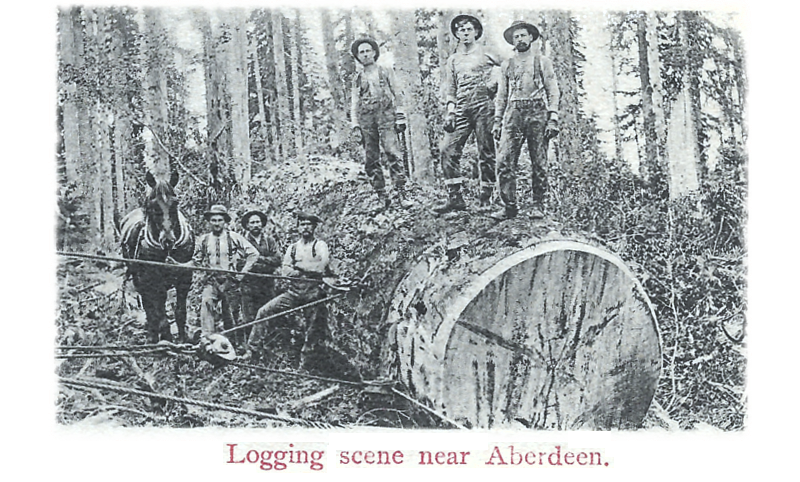MAN, MYTH, LEGEND

One of the only known photographs of Paul
Bunyan, then unknown, taken two springs before the Winter of the Blue
Snow. Digitally colorized and enhanced. Courtesy of Lumberwoods,
Unnatural History Museum
While his likeness looms over the pines, Paul Bunyan (1820-1922), himself, was a big man but probably no more than seven feet on record. While his height may have been exaggerated, he was certainly no myth and every bit a stoic in life as his statues suggest. His history is well documented and accounted for by the numerous loggers who knew him personally or were part of his crew. While French-Canadian by birth, he was a lumberjack of note particularly in the provinces of British Columbia and Ontario, the states of Wisconsin, Minnesota and Michigan, as far east as Maine, and west towards Washington, Oregon and California.
In commemoration, precisely two-hundred years after his birth, it is our esteemed honor to present the collected legend of Paul Bunyan chronicling his life and work in order to dispel the many myths that may have arisen since his passing. As well, his eulogy will be published here publically for the first time. This is done in accordance with his last will and testament, so that the name Paul Bunyan may live anew exactly ninety-eight years following his death, being the same length of time it took a logger to walk around his camp—once.
PAUL BUNYAN is a name like no other, yes sir. You might've could've heard of it or “heerd it” for those who practise their “lumberjack” before sun-up. 'Cause Paul, he, ain't no or'nary fella, oh, no sir. Paul, his legend is one of mythic proportions; stretchin' all the way back a good hundred year as it is. But his story is one full of confusion, folks, they, get it all gaumed up, y'see? All cattywampused as it were.
Yes, I says “cattywampused.”
Hi, by the by, I'm Lenwood, I edit this site. That's what I do, y'see? Mm-hmm. Work this site, what I said. So, you might say, and I can rightly say, and I do say,—
I work for Paul.
Well now, ain't too many who what can claim that thesen days, but I can 'cause who else gone be showin' everyone round these parts? Get comfortable, sit on down, grab your dog, get your gun, whatever your fancy. 'Cause it's like I told ya, 'bout high time somebody told Paul's story RIGHT. Now, that's just what this here is, what were fixin' to do, y'see?
Well, what I'm sayin', if you are on the lookout for Paul, my friend, you sure have come to the right place, yes sir!
Who is Paul Bunyan? Why, got ya the short answer right here:
“Paul Bunyan, as all lumbermen know, was the mythical giant lumberjack who cut the biggest trees, ate the biggest pancakes and drove the largest oxen known to history.”
—Anonymous, Lumber World Review, August 25, 1916, Vol. XXXI, No. 4, Chicago, Illinois
Long answer, but first a little word of—
WARNING!
If that explanation be to your satisfaction, why don't ya turn on back now, look away and search no further? C'mon, mosey, break trail, vamose! 'Cause what lies ahead, boy oh boy, it is tell of someone who ain't got no rival, who ain't got no equal! Nuff make your toes curl up, head stand on end and hair turn white! Best to ere on the side of caution, less you tenderfoots compare y'selves to Paul and get a blow to the old ego so powerful it knocks ya back into yesterday or the time of Paul Bunyan, hisself! Yes sir, ain't there ever been nobody or will be nobody like ol’ Paul, y'hear? Too much awesome for some folks to comprehend, y'see?
Well, the fact the matter is, how an old logger once put it:
“They were all great men, but even so, the name of Paul Bunyan stands a little higher than the rest. It glows like a brilliant star among the lesser ones to encourage men on to deeds of greatness.”
— W.L. Bartholet, The Seatle Star, Nov. 23, 1920, vol. 23, Seattle, Washington
Well, reader should you be dead set on investigatin' the man, the myth, the legend, and be you so determined that not the blow from Paul’s dinner horn nor chill of a blue snow could dissuade ya, than we won't stand in your way. Paul, he always prided such diligence, as it is often repeated that:
“Bunyan's crew was so large that he was obliged to divide the men into three gangs; of these one was always going to work, one was always at work, and the third was always coming home from work. ”
— K. Bernice Stewart and Homer A. Watt, “Legends of Paul Bunyan, Lumberjack.”

But if it helps in your consideration, the legend of the man, presented here today, has been looked over, and vetted, and rechecked, and all that with careful eyes. Incidentally, no material here has been included that ain't the genuine article. True, we did not see it for ourselves, 'cept some of the old, old timers, but, if it is a little comfort, you have our solemn oath that all here has been determined, using the latest scientific methodology, to be beyond any unreasonable doubt. And, without further adieu, we place this here seal as certification of authenticity, so our readers may know that what they are reading may be vouch for on a stack of Munchhausens as absolutely authentic.
* * *
TALES

— Roy H. Jones, “Rhinelander,” Hardwood Record, February 10, 1917, vol. XLII, no. 8
* * *
— Anonymous, “New Light on Paul Bunyan,” American Forests, April, 1929, vol. 35, no. 4
* * *
“Bunyan was a powerful giant, seven feet tall and with a stride of seven feet. He was famous throughout the lumbering districts for his physical strength and for the ingenuity with which he met difficult situations. He was so powerful that no man could successfully oppose him, and his ability to get drunk was proverbial. So great was his lung capacity that he called his men to dinner by blowing through a hollow tree a blast so strong that it blew down the timber on a tract of sixty acres, and when he spoke, the limbs sometimes fell from the trees. To keep his pipe filled required the entire time of a swamper with a scoop-shovel. In the gentle art of writing Bunyan had, however, no skill. He kept his men's time by cutting notches in a stick of wood, and he ordered supplies for camp by drawing pictures of what he wanted. On one occasion only did his ingenuity fail; he ordered grindstones and got cheeses. ‘Oh,’ says Paul, ‘I forgot to put the holes in my grindstones’ [a revolving granite-wheel used to sharpen axes].”
— K. Bernice Stewart and Homer A. Watt, “Legends of Paul Bunyan, Lumberjack.”
* * *
If any one doubt this story, he can find out the truth by going to Roscommon county, near Higgins lake, where Paul had his camp. He dug a well 168 feet and six inches deep. They pulled the curb up when he left, and the last time I was there the sand had blown away and left the hole sticking up in the air 60 feet.”
— A Man from Big Lake, Wash., The Seattle Star, Nov. 24, 1920, vol. 23, Seattle, Washington
* * *
Well, coming right to this place he, h—ll, it was a, just where they come to this river, uh, why they go down and awful hilly. And, and they get right up on there, and, um, they want to grind their axes and didn't know what in the world to do.
Uh, Paul says, ’Well, I'll tell ya boys t-this awful stone here, and you get these here, uh, get your axes hold them right on here now, and have to run a little bit, hold them right on, uh, and round that this here stones [boulders] rolled, and follow them right up, and keep your axes right on these stones, [boulders] and they'll grind them sharp, and chop.’
So they done that [chuckle] and, uh, by God, they set the river on fire!
Yea, but the fella down below there he was gonna kill some hogs at that time, and he had a hundred hogs down there, go—mn it, that river, he didn't have t' [to] boil his water he put 'em right in the river.
He soaked them right there and scolded all his hogs. ”
— Bill McBride in interview with Alan Lomax, August 22, 1938, Mount Pleasant, Michigan
* * *
— Anonymous, “New Light on Paul Bunyan,” American Forests, April, 1929, vol. 35, no. 4
* * *
—Meat Burner, The Seatle Star, Nov. 20, 1920, vol. 23, Seattle, Washington
[ DISCLOSURE: THE FOLLOWING IS REAL!—believe me—READER INDISCRETION IS ADVISED! ]
KEEP READIN' ☞
☜ BACK?
